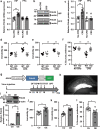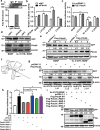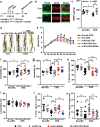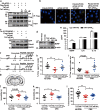Programmed cell death 4 as an endogenous suppressor of BDNF translation is involved in stress-induced depression
- PMID: 32203159
- PMCID: PMC8440200
- DOI: 10.1038/s41380-020-0692-x
Programmed cell death 4 as an endogenous suppressor of BDNF translation is involved in stress-induced depression
Abstract
Brain-derived neurotrophic factor (BDNF) is a growth factor that plays vital roles in the neuron survival, growth, and neuroplasticity. Alteration to BDNF expression is associated with major depressive disorder. However, the BDNF translational machinery in depression remains unknown. Herein, we pointed that Pdcd4, a suppressor oncogene, acted as an endogenous inhibitor for the translation of BDNF, and selectively repressed the translation of BDNF splice variant IIc mRNA in an eIF4A-dependent manner. Chronic restraint stress (CRS) up-regulated Pdcd4 expression in hippocampus via decreasing mTORC1-mediated proteasomes degradation pathway, which resulted in the reduction of BDNF protein expression. Moreover, over-expression of Pdcd4 in the hippocampus triggered spontaneous depression-like behaviors under the non-stressed conditions in mice, while systemic or neuron-specific knockout of Pdcd4 reverses CRS-induced depression-like behaviors. Importantly, administration of Pdcd4 siRNA or an interfering peptide that interrupts the Pdcd4-eIF4A complex substantially promoted BDNF expression and rescued the behavioral disorders which were caused by CRS. Overall, we have discovered a previously unrecognized role of Pdcd4 in controlling BDNF mRNA translation, and provided a new method that boosting BDNF expression through blocking the function of Pdcd4 in depression, indicating that Pdcd4 might be a new potential target for depressive disorder therapy.
© 2020. The Author(s).
Conflict of interest statement
The authors declare that they have no conflict of interest.
Figures





Similar articles
-
Programmed cell death 4 mechanism of action: The model to be updated?Cell Cycle. 2017 Oct 2;16(19):1761-1764. doi: 10.1080/15384101.2017.1371881. Epub 2017 Aug 30. Cell Cycle. 2017. PMID: 28853972 Free PMC article.
-
A novel mechanism for the control of translation of specific mRNAs by tumor suppressor protein Pdcd4: inhibition of translation elongation.Oncogene. 2015 Mar 12;34(11):1384-92. doi: 10.1038/onc.2014.83. Epub 2014 Mar 31. Oncogene. 2015. PMID: 24681950
-
A novel function of the MA-3 domains in transformation and translation suppressor Pdcd4 is essential for its binding to eukaryotic translation initiation factor 4A.Mol Cell Biol. 2004 May;24(9):3894-906. doi: 10.1128/MCB.24.9.3894-3906.2004. Mol Cell Biol. 2004. PMID: 15082783 Free PMC article.
-
Programmed cell death protein 4 (pdcd4): a novel target for antineoplastic therapy?Biol Cell. 2003 Nov;95(8):515-9. doi: 10.1016/j.biolcel.2003.09.003. Biol Cell. 2003. PMID: 14630388 Review.
-
Dissecting the Roles of PDCD4 in Breast Cancer.Front Oncol. 2022 Jun 20;12:855807. doi: 10.3389/fonc.2022.855807. eCollection 2022. Front Oncol. 2022. PMID: 35795053 Free PMC article. Review.
Cited by
-
In Silico Studies and In Vivo MAOA Inhibitory Activity of Coumarins Isolated from Angelica archangelica Extract: An Approach toward Antidepressant Activity.ACS Omega. 2020 Jun 18;5(25):15069-15076. doi: 10.1021/acsomega.0c00887. eCollection 2020 Jun 30. ACS Omega. 2020. PMID: 32637779 Free PMC article.
-
A machine learning model for predicting patients with major depressive disorder: A study based on transcriptomic data.Front Neurosci. 2022 Aug 8;16:949609. doi: 10.3389/fnins.2022.949609. eCollection 2022. Front Neurosci. 2022. PMID: 36003956 Free PMC article.
-
D-mannose is a rapid inducer of ACSS2 to trigger rapid and long-lasting antidepressant responses through augmenting BDNF and TPH2 levels.Transl Psychiatry. 2023 Nov 1;13(1):338. doi: 10.1038/s41398-023-02636-7. Transl Psychiatry. 2023. PMID: 37914710 Free PMC article.
-
PDCD4 regulates axonal growth by translational repression of neurite growth-related genes and is modulated during nerve injury responses.RNA. 2020 Nov;26(11):1637-1653. doi: 10.1261/rna.075424.120. Epub 2020 Aug 3. RNA. 2020. PMID: 32747606 Free PMC article.
-
HSPA12A controls cerebral lactate homeostasis to maintain hippocampal neurogenesis and mood stabilization.Transl Psychiatry. 2023 Aug 14;13(1):280. doi: 10.1038/s41398-023-02573-5. Transl Psychiatry. 2023. PMID: 37580315 Free PMC article.
References
Publication types
MeSH terms
Substances
LinkOut - more resources
Full Text Sources
Other Literature Sources
Miscellaneous

